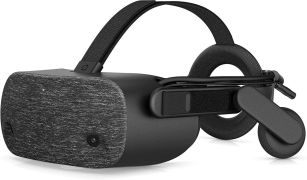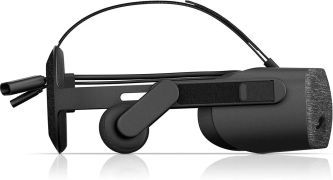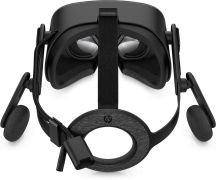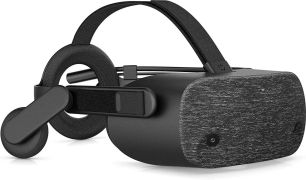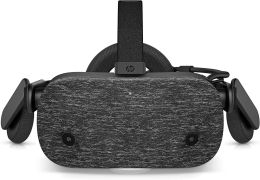HP Reverb G1: Difference between revisions
Xinreality (talk | contribs) Created page with "{{Device Infobox |image = 300px <!-- Placeholder: Replace with actual image --> |VR/AR = Virtual Reality |Type = Head-mounted display |Subtype = Discrete HMD |Platform = Windows Mixed Reality, SteamVR |Creator = HP Inc. |Developer = HP Inc. |Manufacturer = HP Inc. |Announcement Date = March 2019<ref name="YouTube_VROasis_NeedToKnow"/> |Release Date = May/June 2019<ref name="YouTube_Exigeous_Review"/><ref name="AmazonU..." |
Xinreality (talk | contribs) m Text replacement - "Discrete HMD" to "PC-Powered VR" |
||
| (13 intermediate revisions by the same user not shown) | |||
| Line 1: | Line 1: | ||
{{Device Infobox | {{Device Infobox | ||
|image = [[File:HP Reverb | |image = [[File:HP Reverb G16.jpg|300px]] | ||
|VR/AR = [[Virtual Reality]] | |VR/AR = [[Virtual Reality]] | ||
|Type = [[Head-mounted display]] | |Type = [[Head-mounted display]] | ||
|Subtype = | |Subtype = [[PC-Powered VR]] | ||
|Platform = [[Windows Mixed Reality]], [[SteamVR]] | |Platform = [[Windows Mixed Reality]], [[SteamVR]] | ||
|Creator = [[HP Inc.]] | |Creator = [[HP Inc.]] | ||
|Developer = [[HP Inc.]] | |Developer = [[HP Inc.]], [[Microsoft]], [[Valve]] | ||
|Manufacturer = [[HP Inc.]] | |Manufacturer = [[HP Inc.]] | ||
|Announcement Date = March 2019 | |Announcement Date = March 19, 2019 | ||
|Release Date = May | |Release Date = May 1, 2019 | ||
|Price = $599 (Consumer), $649 (Professional Edition) | |Price = $599 (Consumer Edition with controllers), $649 (Professional Edition with controllers) | ||
|Website = | |Website = https://support.hp.com/th-en/product/details/hp-reverb-g1-virtual-reality-headset/28341578 | ||
|Versions = Consumer Edition, Professional Edition | |Versions = Consumer Edition, Professional Edition | ||
|Requires = | |Requires = VR-Ready PC | ||
|Predecessor = [[HP | |Predecessor = [[HP VR1000]] | ||
|Successor = [[HP Reverb G2]] | |Successor = [[HP Reverb G2]] | ||
|Operating System = [[Windows 10]] | |Operating System = [[Windows 10]] | ||
|Display = 2 x LCD | |||
|Subpixel Layout = RGB stripe | |||
|Resolution = 2160 x 2160 per eye (4320 x 2160 total) | |||
|Refresh Rate = 90 Hz | |||
|Field of View = Approx. 114° diagonal (Visible FoV: 95° H / 90° V ) | |||
|Optics = Fresnel-Aspherical | |||
|Ocularity = Binocular | |||
|Display = | |IPD Range = Software adjustment, 63mm fixed physical lenses (+/- 8mm software adjustment, approx. 55-71mm range) | ||
|Subpixel Layout = | |Passthrough = Yes, via tracking cameras ("Mixed Reality Flashlight" mode) | ||
|Tracking = [[Inside-out tracking]], [[6DoF]] | |||
|Resolution = 2160 x 2160 | |Base Stations = None required | ||
|Refresh Rate = 90 Hz | |Eye Tracking = No | ||
|Hand Tracking = No | |||
|Rotational Tracking = Yes | |||
|Positional Tracking = Yes | |||
|Field of View = | |Play Space = Up to 5m x 5m supported | ||
|Audio = Integrated off-ear spatial audio headphones (removable) | |||
|Microphone = Yes, dual integrated microphones | |||
|3.5mm Audio Jack = Yes | |||
|Camera = 2 front-facing cameras for tracking and passthrough | |||
|Connectivity = Bluetooth (built into headset for controllers) | |||
|Ports = Headset connector (proprietary), 3.5mm audio jack | |||
|Wired Video = DisplayPort 1.3, USB 3.0 | |||
|Wireless Video = No | |||
|Optics = | |Bluetooth = Yes (for controllers) | ||
|Ocularity = Binocular | |Power = Via PC connection and cable <!-- G1 also uses tethered power --> | ||
|IPD Range = Software adjustment | |Dimensions = 55 x 177 x 84 mm (without headstrap) / 5.5 x 17.7 x 8.4 cm | ||
|Weight = 433 g (without headstrap), 498 g (with headstrap) / Approx. 500g | |||
|Passthrough = Yes, via tracking cameras ( | |Material = Plastic, fabric front, foam facial interface | ||
|Tracking = [[Inside-out tracking]] | |Headstrap = Elastic padded plastic straps with rear padded ring | ||
|Color = Gray/Black | |||
|Base Stations = | |Sensors = [[Gyroscope]], [[Accelerometer]], [[Magnetometer]] | ||
|Eye | |Input = [[Windows Mixed Reality Motion Controllers]] | ||
|Cable Length = 4m (standard), 0.6m (for Z VR Backpack PC), quick-release connector / 3.5m (11.5 ft) <!-- Sources conflict, using multiple values --> | |||
|Hand | |||
|Rotational Tracking = Yes | |||
|Positional Tracking = Yes | |||
|Play Space = | |||
|Audio = Integrated | |||
|Microphone = Yes, dual microphones | |||
|3.5mm Audio Jack = Yes | |||
|Camera = 2 front-facing | |||
|Connectivity = | |||
|Ports = | |||
|Wired Video = | |||
|Wireless Video = No | |||
|Bluetooth = Yes | |||
|Power = Via PC connection | |||
|Dimensions = | |||
|Weight = | |||
|Material = Plastic | |||
|Headstrap = | |||
| | |||
|Sensors = [[ | |||
|Input = [[Windows Mixed Reality | |||
|Cable Length = | |||
}} | }} | ||
'''HP Reverb G1''' is a [[Virtual Reality]] [[ | The '''HP Reverb G1''' (often referred to simply as '''HP Reverb''') is a [[Virtual Reality|VR]] [[Head-mounted display|headset]] developed and manufactured by [[HP Inc.]]. <ref name="vrcompare"/> Announced in March 2019 and released shortly after in May 2019, it represented HP's second major entry into the VR market, succeeding the [[HP VR1000]]. <ref name="vrcompare"/><ref name="pcmag"/><ref name="r2vr-g2announce"/> It was primarily known for its high [[resolution]] [[LCD]] panels, aiming to reduce the [[Screen-door effect|screen-door effect]] common in headsets of its time. <ref name="pcmag"/><ref name="techradar"/> The Reverb G1 operates on the [[Windows Mixed Reality]] platform but is also compatible with [[SteamVR]]. <ref name="vrcompare"/><ref name="pcmag"/> It has since been discontinued and succeeded by the [[HP Reverb G2]]. <ref name="vrcompare"/><ref name="btr-review">{{cite web |url=https://babeltechreviews.com/testing-benchmarking-the-hp-reverb-g2-vs-the-hp-g1-and-htc-vive-pro/ |title=Testing & Benchmarking the HP Reverb G2 vs. the HP G1 and HTC Vive Pro |date=2021-02-05 |website=BabelTechReviews |access-date=2025-05-03}}</ref><ref name="frontier">{{cite web |url=https://forums.frontier.co.uk/threads/vr-headset-to-replace-g2-reverb.624685/post-10314740 |title=VR headset to replace G2 reverb - Response |date=2024-03-06 |website=Frontier Forums |access-date=2025-05-03}}</ref> | ||
== | == Design and Comfort == | ||
The HP Reverb G1 | The HP Reverb G1 features a design reminiscent of the original [[Oculus Rift]] and [[Google Daydream View]], with a blend of plastic and fabric materials on the exterior. <ref name="techradar"/> It utilizes a three-point harness system with Velcro straps on the sides and top, connecting to a padded ring that rests against the back of the user's head, similar to the Oculus Rift series. <ref name="techradar"/><ref name="pcmag"/> The headset itself is relatively lightweight, weighing approximately 498 grams with the headstrap (433g without). <ref name="vrcompare"/> This light weight generally contributes to comfort during use, reducing neck strain. <ref name="techradar"/> | ||
== | The face mask uses foam padding covered in fabric (Consumer Edition) or an easier-to-clean [[Polyurethane#Artificial leather|pleather]]-style material (Professional Edition) and is removable for cleaning. <ref name="techradar"/><ref name="yt-oasis"/> It provides a good seal around the nose to block external light. <ref name="techradar"/> However, some users found the headset could become warm and sweaty during active use, despite some venting. <ref name="techradar"/> Compatibility with glasses can be challenging; larger frames may struggle to fit, and the headset might pull glasses off when removed. <ref name="techradar"/> | ||
A thick, somewhat heavy cable connects the headset to the PC via [[DisplayPort]] 1.3 and [[USB]] 3.0. <ref name="techradar"/><ref name="pcmag"/> This cable was noted by some reviewers as being bulky and hard to ignore during use. <ref name="techradar"/> It features a quick-release connector near the headset. <ref name="boxthislap"/><ref name="hpspecs"/> The Professional Edition included both a standard 4-meter cable and a shorter 0.6-meter cable designed for use with HP's Z VR Backpack PC. <ref name="boxthislap"/><ref name="hpspecs"/> | |||
== | == Display and Optics == | ||
The Reverb G1 | The standout feature of the Reverb G1 is its display. It utilizes two 2.89-inch [[LCD]] panels, each with a resolution of 2160 x 2160 pixels, providing a combined resolution of 4320 x 2160. <ref name="vrcompare"/><ref name="pcmag"/><ref name="bnh"/> This was significantly higher than most contemporary consumer VR headsets like the [[HTC Vive Pro]] or [[Oculus Quest]]. <ref name="pcmag"/> The high resolution, combined with an [[RGB]] stripe subpixel layout, drastically reduces the [[Screen-door effect]], resulting in a very sharp and clear image. <ref name="pcmag"/><ref name="techradar"/><ref name="zestsys"/> The displays operate at a [[Refresh rate|refresh rate]] of 90 [[Hertz|Hz]]. <ref name="vrcompare"/><ref name="pcmag"/> | ||
The headset employs [[Fresnel lens]]es and offers a [[Field of view|field of view]] (FoV) of approximately 114 degrees diagonally. <ref name="techradar"/><ref name="hpspecs"/><ref name="bnh"/> The visible horizontal FoV is around 95 degrees, and the vertical FoV is about 90 degrees. <ref name="vrcompare"/> While the visuals are generally praised for sharpness and color, some reviewers noted occasional issues with the right display flickering or struggling with brightness consistency, potentially related to power delivery. <ref name="techradar"/> | |||
The headset | |||
The Reverb G1 lacks a hardware [[Interpupillary distance|IPD]] adjustment mechanism. <ref name="techradar"/><ref name="pcmag"/> The lenses are physically fixed at a spacing suitable for an IPD of around 63mm. <ref name="techradar"/><ref name="hpspecs"/> Software-based IPD adjustment is available, allowing compensation of +/- 8mm, accommodating an approximate range of 55mm to 71mm. <ref name="techradar"/><ref name="hpspecs"/><ref name="yt-oasis"/> | |||
The Reverb G1 | |||
== | == Tracking and Passthrough == | ||
The Reverb G1 | The Reverb G1 uses the [[Windows Mixed Reality]] [[Inside-out tracking]] system. <ref name="techradar"/><ref name="pcmag"/> It features two front-facing cameras mounted on the headset visor to track the headset's position and orientation in [[Degrees of freedom (mechanics)|6 degrees of freedom]] (6DoF), as well as the included motion controllers. <ref name="vrcompare"/><ref name="techradar"/><ref name="pcmag"/> This system eliminates the need for external sensors or base stations, simplifying setup. <ref name="vrcompare"/><ref name="techradar"/> | ||
== | Reviewers found the rotational tracking to be smooth and accurate. <ref name="techradar"/> However, positional tracking (moving side-to-side or around the play space) and controller tracking were sometimes described as rougher or exhibiting noticeable jitter compared to systems with external tracking or more cameras (like the [[Oculus Rift S]] or subsequent [[HP Reverb G2]]). <ref name="techradar"/><ref name="pcmag"/> Tracking could be lost if controllers were held outside the cameras' view, such as behind the back or sometimes during fast throwing motions. <ref name="techradar"/> | ||
The HP Reverb G1 | |||
The front cameras also enable a video [[Passthrough|passthrough]] feature called "Mixed Reality Flashlight," allowing users to see their real-world surroundings in black and white without removing the headset. <ref name="techradar"/><ref name="amazon-pro"/> The quality was described as low-resolution. <ref name="techradar"/> | |||
== Controllers == | |||
The HP Reverb G1 shipped with the standard first-generation [[Windows Mixed Reality#Motion controllers|WMR motion controllers]]. <ref name="vrcompare"/><ref name="pcmag"/><ref name="btr-review"/> These controllers offer 6DoF tracking via visible [[Light-emitting diode|LED]] rings tracked by the headset's cameras. <ref name="techradar"/> Each controller features a thumbstick, a clickable trackpad, a menu button, a Windows button, an analog trigger, and a grip button. <ref name="pcmag"/><ref name="yt-oasis"/> They are powered by two AA batteries each. <ref name="techradar"/><ref name="hpspecs"/> Unlike some earlier WMR headsets that required pairing controllers to a PC's Bluetooth, the Reverb G1 features built-in Bluetooth in the headset for a direct connection. <ref name="boxthislap"/><ref name="hpspecs"/><ref name="yt-oasis"/><ref name="hp-g2-faq">{{cite web |url=https://h30434.www3.hp.com/t5/Gaming-Accessories/HP-Reverb-G2-Available-Pre-orders-UP-Novembe/td-p/7683877/page/68 |title=Re: HP Reverb G2 Available Pre-orders UP - Novembe... - Page 68 |website=HP Support Community |access-date=2025-05-03}}</ref> | |||
The ergonomics of these controllers were often criticized as being less comfortable than competitors like the Oculus Touch controllers, featuring a somewhat rectangular grip. <ref name="techradar"/><ref name="pcmag"/> Some users also reported issues with the battery covers coming loose during active gameplay, and the haptic feedback (vibration) was described as weak or "anemic". <ref name="pcmag"/><ref name="reddit-g1g2q2">{{cite web |url=https://www.reddit.com/r/HPReverb/comments/jyep0t/our_take_hp_reverb_g1_v_g2_v_quest_2/ |title=Our Take: HP Reverb G1 v G2 v Quest 2 |date=2020-11-21 |website=Reddit |access-date=2025-05-03}}</ref> These controllers are not compatible with the successor HP Reverb G2 headset. <ref name="xplane-forum">{{cite web |url=https://forums.x-plane.org/index.php?/forums/topic/232855-reverb-controllers/&do=findComment&comment=2069389 |title=Reverb controllers - VR in X-Plane 11 |date=2021-01-25 |website=X-Plane.org Forums |access-date=2025-05-03}}</ref> | |||
== Audio == | |||
The Reverb G1 includes integrated off-ear headphones, similar in style to those on the original Oculus Rift. <ref name="techradar"/><ref name="pcmag"/><ref name="yt-oasis"/> These headphones deliver spatial audio and can be adjusted, flipped up, or removed entirely if users prefer to use their own headphones via the headset's 3.5mm audio jack. <ref name="techradar"/><ref name="hpspecs"/><ref name="yt-oasis"/> The headset also features dual integrated microphones for voice input and communication. <ref name="techradar"/><ref name="amazon-pro"/> | |||
== Software and Compatibility == | |||
As a [[Windows Mixed Reality]] (WMR) headset, the Reverb G1 integrates directly with [[Windows 10]]. <ref name="pcmag"/> The primary interface is the [[Windows Mixed Reality#Software|WMR Portal]] and the [[Windows Mixed Reality#Cliff House|Cliff House]], a customizable virtual environment where users can launch [[Application software|apps]] and access [[Windows 10|Windows]] functions. <ref name="pcmag"/><ref name="r2vr-g2specs"/> The [[Microsoft Store]] provides native WMR applications, though its library was considered limited compared to other platforms at the time. <ref name="pcmag"/> | |||
Crucially, the Reverb G1 is also compatible with [[SteamVR]] via the "Windows Mixed Reality for SteamVR" software bridge. <ref name="pcmag"/><ref name="zestsys"/> This allows access to a much larger library of VR games and applications available on [[Steam (service)|Steam]]. <ref name="techradar"/><ref name="zestsys"/> Setting up and running SteamVR content sometimes required extra steps or troubleshooting compared to native WMR apps. <ref name="techradar"/><ref name="pcmag"/> | |||
Microsoft has announced the deprecation of Windows Mixed Reality, with support ending for consumers on November 1, 2026. After this date, the WMR Portal software and SteamVR driver may become unavailable, potentially rendering WMR headsets like the Reverb G1 unusable, especially on future Windows updates (like Windows 11 24H2 and later) that remove the platform. <ref name="reddit-g2-disc">{{cite web |url=https://www.reddit.com/r/SteamVR/comments/18p4gcr/goodbye_hp_reverb_g2_what_happened_and_whats_next/ |title=Goodbye HP Reverb G2 – What Happened and What's Next? |date=2024-12-23 |website=Reddit |access-date=2025-05-03}}</ref><ref name="ms-community">{{cite web |url=https://answers.microsoft.com/en-us/windows/forum/all/hp-reverb-g2-windows-11-24h2-not-working-need/c0b2d706-8a8e-4e26-a554-a95c8a769a47 |title=HP Reverb G2 + Windows 11 24H2 Not Working Need Help |date=2024-11-18 |website=Microsoft Community |access-date=2025-05-03}}</ref><ref name="frontier"/><ref name="tomshardware-forum">{{cite web |url=https://forums.tomshardware.com/threads/if-you-have-the-vr-headset-hp-reverb-g2-its-been-removed-with-the-latest-windows-update-24h2-being-release-in-october-of-2024.3874946/ |title=If you have the VR headset HP reverb G2 it's been removed with the latest windows update 24H2 being release in October of 2024. |date=2024-10-07 |website=Tom's Hardware Forum |access-date=2025-05-03}}</ref> | |||
== System Requirements == | |||
Due to its high resolution, the Reverb G1 required a relatively powerful PC compared to lower-resolution headsets of the time. Recommended specifications included: | |||
*'''[[GPU]]''': [[Nvidia GeForce|NVIDIA GeForce GTX 1080]], [[Nvidia Quadro|NVIDIA Quadro P5200]], [[AMD Radeon Pro|AMD Radeon Pro WX 8200]], or better (DirectX 12 capable). <ref name="pcmag"/><ref name="boxthislap"/><ref name="bnh"/> Some sources list RX 5700 as an alternative AMD recommendation. <ref name="unbound-specs">{{cite web |url=https://www.unboundxr.com/blogs/news/is-your-pc-ready-for-vr |title=Is your PC ready for VR? |website=Unbound XR |access-date=2025-05-03}}</ref> | |||
*'''[[CPU]]''': [[Intel Core i7]], [[Intel Xeon|Intel Xeon E3-1240 v5]], or better. <ref name="pcmag"/><ref name="boxthislap"/><ref name="bnh"/> Some sources list Core i5 or Ryzen 5 as alternatives. <ref name="unbound-specs"/> | |||
*'''[[RAM]]''': 16GB RAM or more. <ref name="pcmag"/><ref name="boxthislap"/><ref name="bnh"/> Some sources list 8GB as minimum/recommended. <ref name="unbound-specs"/> | |||
*'''Video Output''': [[DisplayPort]] 1.3. <ref name="pcmag"/><ref name="boxthislap"/><ref name="unbound-specs"/> | |||
*'''[[USB]] Ports''': 1x USB 3.0. <ref name="pcmag"/><ref name="boxthislap"/><ref name="unbound-specs"/> | |||
*'''[[Operating System]]''': [[Windows 10]] (October 2018 update or later). <ref name="boxthislap"/><ref name="pcmag"/><ref name="unbound-specs"/> | |||
== Reception == | == Reception == | ||
The HP Reverb G1 received | The HP Reverb G1 received mixed reviews. Its high-resolution display was widely praised as its strongest feature, offering excellent visual clarity and significantly reducing the screen-door effect, making it particularly appealing for simulation games (like flight or racing sims) and professional applications where detail is important. <ref name="techradar"/><ref name="pcmag"/><ref name="btr-review"/><ref name="amazon-pro"/> The headset's comfort due to its light weight and the simplicity of the inside-out tracking setup were also noted as positives. <ref name="techradar"/><ref name="pcmag"/> | ||
However, the headset faced criticism for several aspects. The Windows Mixed Reality platform and software were often seen as less refined and having a smaller content library compared to Oculus or SteamVR ecosystems. <ref name="techradar"/><ref name="pcmag"/> The inside-out tracking, while convenient, was considered less robust and prone to more jitter and controller occlusion issues than competing systems, particularly impacting experiences requiring fast or wide arm movements. <ref name="techradar"/><ref name="pcmag"/> The first-generation WMR controllers were criticized for their ergonomics and occasionally loose battery covers. <ref name="techradar"/><ref name="pcmag"/> The lack of hardware IPD adjustment was a drawback for users outside the optimal range, and the thick cable was cumbersome. <ref name="techradar"/><ref name="pcmag"/> Some users also reported reliability issues. <ref name="amazon-pro"/> | |||
Overall, it was seen as a headset offering best-in-class visual fidelity for its time, but compromised by limitations in tracking, controller design, and the WMR software environment. <ref name="techradar"/><ref name="pcmag"/><ref name="btr-review"/> | |||
==Images== | |||
<gallery mode="packed"> | |||
File:HP Reverb G11.jpg | |||
File:HP Reverb G12.jpg | |||
File:HP Reverb G13.jpg | |||
File:HP Reverb G14.jpg | |||
File:HP Reverb G16.jpg | |||
</gallery> | |||
== References == | == References == | ||
<references> | <references> | ||
<ref name=" | <ref name="vrcompare">{{cite web |url=https://vr-compare.com/headset/hpreverb |title=HP Reverb Specs |website=VR Compare |access-date=2025-05-03}}</ref> | ||
<ref name=" | <ref name="techradar">{{cite web |url=https://www.techradar.com/reviews/hp-reverb-vr-headset |title=HP Reverb VR Headset review |last=Knapp |first=Mark |date=2019-07-18 |website=TechRadar |access-date=2025-05-03}}</ref> | ||
<ref name=" | <ref name="pcmag">{{cite web |url=https://www.pcmag.com/reviews/hp-reverb |title=HP Reverb Review |last=Greenwald |first=Will |date=2019-05-22 |website=PCMag |access-date=2025-05-03}}</ref> | ||
<ref name=" | <ref name="hpspecs">{{cite web |url=https://h20195.www2.hp.com/v2/GetDocument.aspx?docname=c06227520 |title=QuickSpecs HP Reverb Virtual Reality Headset - Professional Edition |date=2019-10-08 |website=HP Inc. |access-date=2025-05-03}}</ref> | ||
<ref name=" | <ref name="boxthislap">{{cite web |url=https://boxthislap.org/hp-reverb-g1/ |title=HP Reverb G1 |last=Gonzalo |date=2020-07-18 |website=BoxThisLap |access-date=2025-05-03}}</ref> | ||
<ref name=" | <ref name="bnh">{{cite web |url=https://www.bhphotovideo.com/c/product/1495009-REG/hp_7dh40ut_aba_reverb_virtual_reality_headset.html/specs |title=HP Reverb Virtual Reality Headset (Professional Edition) Specs |website=B&H Photo Video |access-date=2025-05-03}}</ref> | ||
<ref name=" | <ref name="r2vr-g2announce">{{cite web |url=https://www.roadtovr.com/hp-reverb-g2-price-release-date-pre-order/ |title=HP Announces Reverb G2 – Price, Pre-orders, and Release Date |last=Lang |first=Ben |date=2020-07-09 |website=Road to VR |access-date=2025-05-03}}</ref> | ||
<ref name=" | <ref name="zestsys">{{cite web |url=https://zestsystems.com/product/hp-reverb-virtual-reality-headset-7fu78pa/ |title=HP Reverb VR Headset G1 |website=Zest Systems |access-date=2025-05-03}}</ref> | ||
<ref name=" | <ref name="yt-oasis">{{cite web |url=https://www.youtube.com/watch?v=3Vtsqf47hOQ&t=1s |title=HP Reverb - Everything you NEED to know |last=Virtual Reality Oasis |date=2019-03-26 |website=YouTube |access-date=2025-05-03}}</ref> | ||
<ref name=" | <ref name="amazon-pro">{{cite web |url=https://www.amazon.com/HP-Reverb-Virtual-Reality-Headset-Professional/dp/B07WCX76C7 |title=HP Reverb Virtual Reality Headset - Professional Edition |website=Amazon.com |access-date=2025-05-03}}</ref> | ||
<ref name=" | <ref name="r2vr-g2specs">{{cite web |url=https://www.roadtovr.com/hp-reverb-g2-review-specs-windows-vr/ |title=HP Reverb G2 Review – Screen Door No More |last=Lang |first=Ben |date=2020-11-18 |website=Road to VR |access-date=2025-05-03}}</ref> | ||
<ref name="btr-review">{{cite web |url=https://babeltechreviews.com/testing-benchmarking-the-hp-reverb-g2-vs-the-hp-g1-and-htc-vive-pro/ |title=Testing & Benchmarking the HP Reverb G2 vs. the HP G1 and HTC Vive Pro |date=2021-02-05 |website=BabelTechReviews |access-date=2025-05-03}}</ref> | |||
<ref name=" | <ref name="frontier">{{cite web |url=https://forums.frontier.co.uk/threads/vr-headset-to-replace-g2-reverb.624685/post-10314740 |title=VR headset to replace G2 reverb - Response |date=2024-03-06 |website=Frontier Forums |access-date=2025-05-03}}</ref> | ||
<ref name=" | <ref name="hp-g2-faq">{{cite web |url=https://h30434.www3.hp.com/t5/Gaming-Accessories/HP-Reverb-G2-Available-Pre-orders-UP-Novembe/td-p/7683877/page/68 |title=Re: HP Reverb G2 Available Pre-orders UP - Novembe... - Page 68 |website=HP Support Community |access-date=2025-05-03}}</ref> | ||
<ref name=" | <ref name="reddit-g1g2q2">{{cite web |url=https://www.reddit.com/r/HPReverb/comments/jyep0t/our_take_hp_reverb_g1_v_g2_v_quest_2/ |title=Our Take: HP Reverb G1 v G2 v Quest 2 |date=2020-11-21 |website=Reddit |access-date=2025-05-03}}</ref> | ||
<ref name=" | <ref name="xplane-forum">{{cite web |url=https://forums.x-plane.org/index.php?/forums/topic/232855-reverb-controllers/&do=findComment&comment=2069389 |title=Reverb controllers - VR in X-Plane 11 |date=2021-01-25 |website=X-Plane.org Forums |access-date=2025-05-03}}</ref> | ||
<ref name=" | <ref name="reddit-g2-disc">{{cite web |url=https://www.reddit.com/r/SteamVR/comments/18p4gcr/goodbye_hp_reverb_g2_what_happened_and_whats_next/ |title=Goodbye HP Reverb G2 – What Happened and What's Next? |date=2024-12-23 |website=Reddit |access-date=2025-05-03}}</ref> | ||
<ref name=" | <ref name="ms-community">{{cite web |url=https://answers.microsoft.com/en-us/windows/forum/all/hp-reverb-g2-windows-11-24h2-not-working-need/c0b2d706-8a8e-4e26-a554-a95c8a769a47 |title=HP Reverb G2 + Windows 11 24H2 Not Working Need Help |date=2024-11-18 |website=Microsoft Community |access-date=2025-05-03}}</ref> | ||
<ref name=" | <ref name="tomshardware-forum">{{cite web |url=https://forums.tomshardware.com/threads/if-you-have-the-vr-headset-hp-reverb-g2-its-been-removed-with-the-latest-windows-update-24h2-being-release-in-october-of-2024.3874946/ |title=If you have the VR headset HP reverb G2 it's been removed with the latest windows update 24H2 being release in October of 2024. |date=2024-10-07 |website=Tom's Hardware Forum |access-date=2025-05-03}}</ref> | ||
<ref name=" | <ref name="unbound-specs">{{cite web |url=https://www.unboundxr.com/blogs/news/is-your-pc-ready-for-vr |title=Is your PC ready for VR? |website=Unbound XR |access-date=2025-05-03}}</ref> | ||
</references> | </references> | ||
[[Category:Virtual Reality Headsets]] | [[Category:Virtual Reality Devices]] | ||
[[Category:VR Headsets]] | |||
[[Category:Head-mounted displays]] | |||
[[Category:HP Inc.]] | [[Category:HP Inc.]] | ||
[[Category:Windows Mixed Reality]] | [[Category:Windows Mixed Reality]] | ||
[[Category: | [[Category:Discontinued products]] | ||
[[Category: | [[Category:Virtual Reality]] | ||
Latest revision as of 16:10, 4 May 2025
| HP Reverb G1 | |
|---|---|
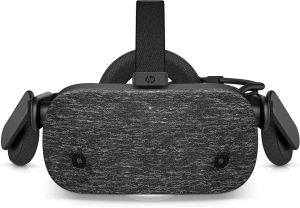
| |
| Basic Info | |
| VR/AR | Virtual Reality |
| Type | Head-mounted display |
| Subtype | PC-Powered VR |
| Platform | Windows Mixed Reality, SteamVR |
| Creator | HP Inc. |
| Developer | HP Inc., Microsoft, Valve |
| Manufacturer | HP Inc. |
| Announcement Date | March 19, 2019 |
| Release Date | May 1, 2019 |
| Price | $599 (Consumer Edition with controllers), $649 (Professional Edition with controllers) |
| Website | https://support.hp.com/th-en/product/details/hp-reverb-g1-virtual-reality-headset/28341578 |
| Versions | Consumer Edition, Professional Edition |
| Requires | VR-Ready PC |
| Predecessor | HP VR1000 |
| Successor | HP Reverb G2 |
| System | |
| Operating System | Windows 10 |
| Storage | |
| Display | |
| Display | 2 x LCD |
| Subpixel Layout | RGB stripe |
| Resolution | 2160 x 2160 per eye (4320 x 2160 total) |
| Refresh Rate | 90 Hz |
| Image | |
| Field of View | Approx. 114° diagonal (Visible FoV: 95° H / 90° V ) |
| Optics | |
| Optics | Fresnel-Aspherical |
| Ocularity | Binocular |
| IPD Range | Software adjustment, 63mm fixed physical lenses (+/- 8mm software adjustment, approx. 55-71mm range) |
| Passthrough | Yes, via tracking cameras ("Mixed Reality Flashlight" mode) |
| Tracking | |
| Tracking | Inside-out tracking, 6DoF |
| Base Stations | None required |
| Eye Tracking | No |
| Hand Tracking | No |
| Rotational Tracking | Yes |
| Positional Tracking | Yes |
| Play Space | Up to 5m x 5m supported |
| Audio | |
| Audio | Integrated off-ear spatial audio headphones (removable) |
| Microphone | Yes, dual integrated microphones |
| 3.5mm Audio Jack | Yes |
| Camera | 2 front-facing cameras for tracking and passthrough |
| Connectivity | |
| Connectivity | Bluetooth (built into headset for controllers) |
| Ports | Headset connector (proprietary), 3.5mm audio jack |
| Wired Video | DisplayPort 1.3, USB 3.0 |
| Wireless Video | No |
| Bluetooth | Yes (for controllers) |
| Power | Via PC connection and cable |
| Device | |
| Dimensions | 55 x 177 x 84 mm (without headstrap) / 5.5 x 17.7 x 8.4 cm |
| Weight | 433 g (without headstrap), 498 g (with headstrap) / Approx. 500g |
| Material | Plastic, fabric front, foam facial interface |
| Headstrap | Elastic padded plastic straps with rear padded ring |
| Color | Gray/Black |
| Sensors | Gyroscope, Accelerometer, Magnetometer |
| Input | Windows Mixed Reality Motion Controllers |
| Cable Length | 4m (standard), 0.6m (for Z VR Backpack PC), quick-release connector / 3.5m (11.5 ft) |
The HP Reverb G1 (often referred to simply as HP Reverb) is a VR headset developed and manufactured by HP Inc.. [1] Announced in March 2019 and released shortly after in May 2019, it represented HP's second major entry into the VR market, succeeding the HP VR1000. [1][2][3] It was primarily known for its high resolution LCD panels, aiming to reduce the screen-door effect common in headsets of its time. [2][4] The Reverb G1 operates on the Windows Mixed Reality platform but is also compatible with SteamVR. [1][2] It has since been discontinued and succeeded by the HP Reverb G2. [1][5][6]
Design and Comfort
The HP Reverb G1 features a design reminiscent of the original Oculus Rift and Google Daydream View, with a blend of plastic and fabric materials on the exterior. [4] It utilizes a three-point harness system with Velcro straps on the sides and top, connecting to a padded ring that rests against the back of the user's head, similar to the Oculus Rift series. [4][2] The headset itself is relatively lightweight, weighing approximately 498 grams with the headstrap (433g without). [1] This light weight generally contributes to comfort during use, reducing neck strain. [4]
The face mask uses foam padding covered in fabric (Consumer Edition) or an easier-to-clean pleather-style material (Professional Edition) and is removable for cleaning. [4][7] It provides a good seal around the nose to block external light. [4] However, some users found the headset could become warm and sweaty during active use, despite some venting. [4] Compatibility with glasses can be challenging; larger frames may struggle to fit, and the headset might pull glasses off when removed. [4]
A thick, somewhat heavy cable connects the headset to the PC via DisplayPort 1.3 and USB 3.0. [4][2] This cable was noted by some reviewers as being bulky and hard to ignore during use. [4] It features a quick-release connector near the headset. [8][9] The Professional Edition included both a standard 4-meter cable and a shorter 0.6-meter cable designed for use with HP's Z VR Backpack PC. [8][9]
Display and Optics
The standout feature of the Reverb G1 is its display. It utilizes two 2.89-inch LCD panels, each with a resolution of 2160 x 2160 pixels, providing a combined resolution of 4320 x 2160. [1][2][10] This was significantly higher than most contemporary consumer VR headsets like the HTC Vive Pro or Oculus Quest. [2] The high resolution, combined with an RGB stripe subpixel layout, drastically reduces the Screen-door effect, resulting in a very sharp and clear image. [2][4][11] The displays operate at a refresh rate of 90 Hz. [1][2]
The headset employs Fresnel lenses and offers a field of view (FoV) of approximately 114 degrees diagonally. [4][9][10] The visible horizontal FoV is around 95 degrees, and the vertical FoV is about 90 degrees. [1] While the visuals are generally praised for sharpness and color, some reviewers noted occasional issues with the right display flickering or struggling with brightness consistency, potentially related to power delivery. [4]
The Reverb G1 lacks a hardware IPD adjustment mechanism. [4][2] The lenses are physically fixed at a spacing suitable for an IPD of around 63mm. [4][9] Software-based IPD adjustment is available, allowing compensation of +/- 8mm, accommodating an approximate range of 55mm to 71mm. [4][9][7]
Tracking and Passthrough
The Reverb G1 uses the Windows Mixed Reality Inside-out tracking system. [4][2] It features two front-facing cameras mounted on the headset visor to track the headset's position and orientation in 6 degrees of freedom (6DoF), as well as the included motion controllers. [1][4][2] This system eliminates the need for external sensors or base stations, simplifying setup. [1][4]
Reviewers found the rotational tracking to be smooth and accurate. [4] However, positional tracking (moving side-to-side or around the play space) and controller tracking were sometimes described as rougher or exhibiting noticeable jitter compared to systems with external tracking or more cameras (like the Oculus Rift S or subsequent HP Reverb G2). [4][2] Tracking could be lost if controllers were held outside the cameras' view, such as behind the back or sometimes during fast throwing motions. [4]
The front cameras also enable a video passthrough feature called "Mixed Reality Flashlight," allowing users to see their real-world surroundings in black and white without removing the headset. [4][12] The quality was described as low-resolution. [4]
Controllers
The HP Reverb G1 shipped with the standard first-generation WMR motion controllers. [1][2][5] These controllers offer 6DoF tracking via visible LED rings tracked by the headset's cameras. [4] Each controller features a thumbstick, a clickable trackpad, a menu button, a Windows button, an analog trigger, and a grip button. [2][7] They are powered by two AA batteries each. [4][9] Unlike some earlier WMR headsets that required pairing controllers to a PC's Bluetooth, the Reverb G1 features built-in Bluetooth in the headset for a direct connection. [8][9][7][13]
The ergonomics of these controllers were often criticized as being less comfortable than competitors like the Oculus Touch controllers, featuring a somewhat rectangular grip. [4][2] Some users also reported issues with the battery covers coming loose during active gameplay, and the haptic feedback (vibration) was described as weak or "anemic". [2][14] These controllers are not compatible with the successor HP Reverb G2 headset. [15]
Audio
The Reverb G1 includes integrated off-ear headphones, similar in style to those on the original Oculus Rift. [4][2][7] These headphones deliver spatial audio and can be adjusted, flipped up, or removed entirely if users prefer to use their own headphones via the headset's 3.5mm audio jack. [4][9][7] The headset also features dual integrated microphones for voice input and communication. [4][12]
Software and Compatibility
As a Windows Mixed Reality (WMR) headset, the Reverb G1 integrates directly with Windows 10. [2] The primary interface is the WMR Portal and the Cliff House, a customizable virtual environment where users can launch apps and access Windows functions. [2][16] The Microsoft Store provides native WMR applications, though its library was considered limited compared to other platforms at the time. [2]
Crucially, the Reverb G1 is also compatible with SteamVR via the "Windows Mixed Reality for SteamVR" software bridge. [2][11] This allows access to a much larger library of VR games and applications available on Steam. [4][11] Setting up and running SteamVR content sometimes required extra steps or troubleshooting compared to native WMR apps. [4][2]
Microsoft has announced the deprecation of Windows Mixed Reality, with support ending for consumers on November 1, 2026. After this date, the WMR Portal software and SteamVR driver may become unavailable, potentially rendering WMR headsets like the Reverb G1 unusable, especially on future Windows updates (like Windows 11 24H2 and later) that remove the platform. [17][18][6][19]
System Requirements
Due to its high resolution, the Reverb G1 required a relatively powerful PC compared to lower-resolution headsets of the time. Recommended specifications included:
- GPU: NVIDIA GeForce GTX 1080, NVIDIA Quadro P5200, AMD Radeon Pro WX 8200, or better (DirectX 12 capable). [2][8][10] Some sources list RX 5700 as an alternative AMD recommendation. [20]
- CPU: Intel Core i7, Intel Xeon E3-1240 v5, or better. [2][8][10] Some sources list Core i5 or Ryzen 5 as alternatives. [20]
- RAM: 16GB RAM or more. [2][8][10] Some sources list 8GB as minimum/recommended. [20]
- Video Output: DisplayPort 1.3. [2][8][20]
- USB Ports: 1x USB 3.0. [2][8][20]
- Operating System: Windows 10 (October 2018 update or later). [8][2][20]
Reception
The HP Reverb G1 received mixed reviews. Its high-resolution display was widely praised as its strongest feature, offering excellent visual clarity and significantly reducing the screen-door effect, making it particularly appealing for simulation games (like flight or racing sims) and professional applications where detail is important. [4][2][5][12] The headset's comfort due to its light weight and the simplicity of the inside-out tracking setup were also noted as positives. [4][2]
However, the headset faced criticism for several aspects. The Windows Mixed Reality platform and software were often seen as less refined and having a smaller content library compared to Oculus or SteamVR ecosystems. [4][2] The inside-out tracking, while convenient, was considered less robust and prone to more jitter and controller occlusion issues than competing systems, particularly impacting experiences requiring fast or wide arm movements. [4][2] The first-generation WMR controllers were criticized for their ergonomics and occasionally loose battery covers. [4][2] The lack of hardware IPD adjustment was a drawback for users outside the optimal range, and the thick cable was cumbersome. [4][2] Some users also reported reliability issues. [12]
Overall, it was seen as a headset offering best-in-class visual fidelity for its time, but compromised by limitations in tracking, controller design, and the WMR software environment. [4][2][5]
Images
References
- ↑ 1.00 1.01 1.02 1.03 1.04 1.05 1.06 1.07 1.08 1.09 1.10 "HP Reverb Specs". https://vr-compare.com/headset/hpreverb.
- ↑ 2.00 2.01 2.02 2.03 2.04 2.05 2.06 2.07 2.08 2.09 2.10 2.11 2.12 2.13 2.14 2.15 2.16 2.17 2.18 2.19 2.20 2.21 2.22 2.23 2.24 2.25 2.26 2.27 2.28 2.29 2.30 2.31 2.32 2.33 2.34 2.35 Greenwald, Will (2019-05-22). "HP Reverb Review". https://www.pcmag.com/reviews/hp-reverb.
- ↑ Lang, Ben (2020-07-09). "HP Announces Reverb G2 – Price, Pre-orders, and Release Date". https://www.roadtovr.com/hp-reverb-g2-price-release-date-pre-order/.
- ↑ 4.00 4.01 4.02 4.03 4.04 4.05 4.06 4.07 4.08 4.09 4.10 4.11 4.12 4.13 4.14 4.15 4.16 4.17 4.18 4.19 4.20 4.21 4.22 4.23 4.24 4.25 4.26 4.27 4.28 4.29 4.30 4.31 4.32 4.33 4.34 4.35 4.36 4.37 4.38 Knapp, Mark (2019-07-18). "HP Reverb VR Headset review". https://www.techradar.com/reviews/hp-reverb-vr-headset.
- ↑ 5.0 5.1 5.2 5.3 "Testing & Benchmarking the HP Reverb G2 vs. the HP G1 and HTC Vive Pro". 2021-02-05. https://babeltechreviews.com/testing-benchmarking-the-hp-reverb-g2-vs-the-hp-g1-and-htc-vive-pro/.
- ↑ 6.0 6.1 "VR headset to replace G2 reverb - Response". 2024-03-06. https://forums.frontier.co.uk/threads/vr-headset-to-replace-g2-reverb.624685/post-10314740.
- ↑ 7.0 7.1 7.2 7.3 7.4 7.5 Virtual Reality Oasis (2019-03-26). "HP Reverb - Everything you NEED to know". https://www.youtube.com/watch?v=3Vtsqf47hOQ&t=1s.
- ↑ 8.0 8.1 8.2 8.3 8.4 8.5 8.6 8.7 8.8 Gonzalo (2020-07-18). "HP Reverb G1". https://boxthislap.org/hp-reverb-g1/.
- ↑ 9.0 9.1 9.2 9.3 9.4 9.5 9.6 9.7 "QuickSpecs HP Reverb Virtual Reality Headset - Professional Edition". 2019-10-08. https://h20195.www2.hp.com/v2/GetDocument.aspx?docname=c06227520.
- ↑ 10.0 10.1 10.2 10.3 10.4 "HP Reverb Virtual Reality Headset (Professional Edition) Specs". https://www.bhphotovideo.com/c/product/1495009-REG/hp_7dh40ut_aba_reverb_virtual_reality_headset.html/specs.
- ↑ 11.0 11.1 11.2 "HP Reverb VR Headset G1". https://zestsystems.com/product/hp-reverb-virtual-reality-headset-7fu78pa/.
- ↑ 12.0 12.1 12.2 12.3 "HP Reverb Virtual Reality Headset - Professional Edition". https://www.amazon.com/HP-Reverb-Virtual-Reality-Headset-Professional/dp/B07WCX76C7.
- ↑ "Re: HP Reverb G2 Available Pre-orders UP - Novembe... - Page 68". https://h30434.www3.hp.com/t5/Gaming-Accessories/HP-Reverb-G2-Available-Pre-orders-UP-Novembe/td-p/7683877/page/68.
- ↑ "Our Take: HP Reverb G1 v G2 v Quest 2". 2020-11-21. https://www.reddit.com/r/HPReverb/comments/jyep0t/our_take_hp_reverb_g1_v_g2_v_quest_2/.
- ↑ "Reverb controllers - VR in X-Plane 11". 2021-01-25. https://forums.x-plane.org/index.php?/forums/topic/232855-reverb-controllers/&do=findComment&comment=2069389.
- ↑ Lang, Ben (2020-11-18). "HP Reverb G2 Review – Screen Door No More". https://www.roadtovr.com/hp-reverb-g2-review-specs-windows-vr/.
- ↑ "Goodbye HP Reverb G2 – What Happened and What's Next?". 2024-12-23. https://www.reddit.com/r/SteamVR/comments/18p4gcr/goodbye_hp_reverb_g2_what_happened_and_whats_next/.
- ↑ "HP Reverb G2 + Windows 11 24H2 Not Working Need Help". 2024-11-18. https://answers.microsoft.com/en-us/windows/forum/all/hp-reverb-g2-windows-11-24h2-not-working-need/c0b2d706-8a8e-4e26-a554-a95c8a769a47.
- ↑ "If you have the VR headset HP reverb G2 it's been removed with the latest windows update 24H2 being release in October of 2024.". 2024-10-07. https://forums.tomshardware.com/threads/if-you-have-the-vr-headset-hp-reverb-g2-its-been-removed-with-the-latest-windows-update-24h2-being-release-in-october-of-2024.3874946/.
- ↑ 20.0 20.1 20.2 20.3 20.4 20.5 "Is your PC ready for VR?". https://www.unboundxr.com/blogs/news/is-your-pc-ready-for-vr.


